
Chris Clarke declared December 1st, 2005, Blog Against Racism Day because it marked the 50th anniversary of Rosa Parks' celebrated civic disobedience in Montgomery, Alabama. I don't believe Clarke intended the call to be observed annually but, four years later, on the heels of a successful "post-race" presidential bid, I'm compelled to touch again on the subject of black-white prejudice in the United States.
This Thanksgiving, my family and friends pondered the possible cultural benefits of Barack Obama's election. Will African American youth have a more positive role model? Will well-educated black men be celebrated by their community rather than labelled an Uncle Tom? Will racial tension decrease? The scene itself - a group of educated white professionals discussing race in between bites of pecan and pumpkin pie - proves that the "post-race" claim is misguided.
Like most liberal whites, I fancy myself free of the prejudice that drives genocide, hate crime and careless discrimination. Indeed, relative to an openly racist individual, I am a tolerant pluralist and hopeful progressive. Nonetheless, biases remain that need to be addressed and, I hope, corrected.
Bill Wilson and Dr. Bob Smith, the co-founders of Alcoholics Anonymous, believed that an addict must admit his shortcomings before he can confront them. In 1939, the two men formulated the original twelve steps of recovery; the fourth step enjoins AA members to make a "searching and fearless moral inventory." Below, I've used such an "inventory" to address my latent bigotry.
Some readers will doubtless consider the exercise an impotent confessional, but by acknowledging the embarrassing biases and feelings, I become more conscious of them and, in turn, better able to erode them. If any of what I've written offends you, please comment.
- When I read reports of the world's happiest nations, I expect the more racially homogeneous countries to top the list. The assumption is wrong-headed. Low levels of poverty/unemployment, freedom of choice, gender equality, and social tolerance are all significant contributing factors to the overall happiness of a given populace, but racial make-up does not figure prominently. Nevertheless, my assumption persists.Barack Obama's election to the highest political office in our country is a hopeful victory over base ignorance and reactionary thinking, but it is also a clarion call for renewed commitment to civil rights. I feel strongly that the best way to begin working for that renewal is a thorough self-assessment. I've assessed, but now I've got work to do.
- I'm occasionally guilty of beginning a statement "Well, my black friends...," as though, because a sizable portion of my circle is African American, I am better able to speak on cultural differences. In fact, I have only two friends who identify as "black," and both are inter-racial, having one Caucasian and one African or African American parent. I do have a number of black acquaintances and professional contacts, but these tenuous connections certainly don't qualify me to speak on the American "black experience."
- When I travel to predominantly African American neighborhoods, I become anxious. I'm not fearful of violence, but I am made uncomfortable by the sense that I represent the oppressor ("the man") and, as such, am a target for resentful stares and verbal harassment. Indeed, I've been spit at, shoulder-checked and called names; my worries may not be unfounded, but they feed a poisonous anger directed both at myself and our American legacy. I am frustrated that, by virtue of my ancestry, I am the face of oppression.
- As a general rule, I assume that black Africans are more optimistic and harder-working than African Americans.
- Although I believe that social decorum is more closely linked to socio-economic class and education, I also assume that African American teens are louder, more physically expressive and less considerate of others than their white counterparts.
- For years I've believed that African Americans comprised the majority population of the Virginia counties I grew up in. I was certain that Accomack, where my hometown is located, had a narrow white majority, but that Northampton, where I attended public school, was predominantly black. In fact, according to the 2006 census, Accomack County is 60% white/non-Hispanic, 30% black and 9% Hispanic. (For those keeping score, that's a 2-to-1 white-black ratio.) Northampton County is 54% white/non-Hispanic, 40% black and 6% Hispanic. To be fair, both counties are home to proportionately more blacks than the United States at large, but my belief, so long held, is undeniably wrong. Furthermore, the only explanation for my inaccurate reckoning is that I noticed the black individuals more, suggesting that I weighted "otherness" heavily.
Photo credit: BBC

4 comments:
Sorry I thought it was a picture of Tokyo Rose only because earlier I was looking up Toyko Rose and this picture looks similar. There was some women earlier out her on the west coast that wouldn't give up her seat also. Every so often you do get an article about her. Will you be writing about Dec 07?
I am behing you 100 percent! Racism, in all its forms, must stop. We, as bloggers, must unit in one voice to enlighten, protest and teach others to do the same. This is just another example of institutional racism. And there are many, many more instances of it, despite the election of the nations first black President. Please check out on my blog and pass it along.
ZZI:
I will not be writing about December 7th, but thank you for checking in.
Iam:
Thank you for visiting. Keep up the good work.
Post a Comment